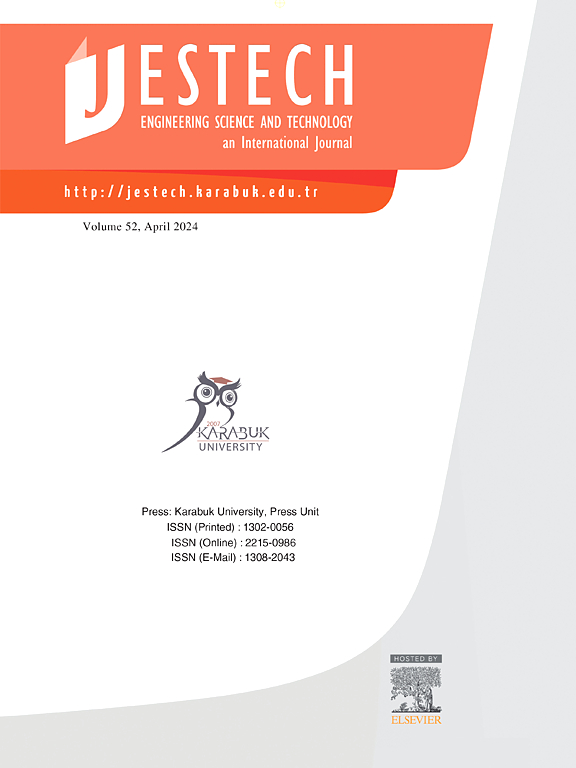Influence of clay mineralogy on undrained cyclic strength of sand with fines
IF 5.1
2区 工程技术
Q1 ENGINEERING, MULTIDISCIPLINARY
Engineering Science and Technology-An International Journal-Jestech
Pub Date : 2024-10-28
DOI:10.1016/j.jestch.2024.101872
引用次数: 0
Abstract
Soils in natural or reclaimed areas frequently contain a mixture of sand, silt, and clay, rather than consisting solely of clean sand. The influence of a small proportion of fine plastic particles within a sandy matrix on liquefaction resistance still remains unclear. For this purpose, the cyclic response of sand with clay is investigated by using two different types of clay (kaolin and montmorillonite) with three different clay content (5, 10, 15%). The influence of clay mineralogy and clay inclusion level on the cyclic behavior of clayey sand is analyzed. The specimens are prepared with 50% relative densities using wet tamping method to ensure homogeneity and consolidated at 100 kPa effective stress. The results show that kaolin and montmorillonite contained sand show contractive response and limited flow type of liquefaction. For kaolin containing sand, specimens containing 5% kaolin showed a increment in resistance while liquefaction resistance decreased on specimens that contained 10% and 15% kaolin. When considering specimens with montmorillonite; in sand with a 5% clay content, a decrease in liquefaction potential was observed, while an increment was obtained in sand containing 10% and 15% clay content. Moreover, between the intergranular void ratio and the liquefaction resistance, a significant relationship is revealed.
粘土矿物学对含细砂的排水循环强度的影响
天然或开垦地区的土壤经常含有砂、粉砂和粘土的混合物,而不是完全由干净的砂组成。砂土基质中少量细塑颗粒对抗液化性能的影响仍不清楚。为此,我们使用两种不同类型的粘土(高岭土和蒙脱石)和三种不同的粘土含量(5%、10%、15%)来研究砂与粘土的循环反应。分析了粘土矿物学和粘土含量对含粘土砂的循环行为的影响。采用湿夯法制备相对密度为 50%的试样以确保其均匀性,并在 100 kPa 有效应力下进行固结。结果表明,含高岭土和蒙脱石的砂表现出收缩响应和限流型液化。对于含高岭土的砂,含 5%高岭土的试样的抗液化能力有所增强,而含 10%和 15%高岭土的试样的抗液化能力则有所减弱。在含蒙脱石的试样中,粘土含量为 5%的砂的液化潜力下降,而粘土含量为 10%和 15%的砂的液化潜力上升。此外,晶间空隙率与抗液化性之间也存在显著关系。
本文章由计算机程序翻译,如有差异,请以英文原文为准。
求助全文
约1分钟内获得全文
求助全文
来源期刊

Engineering Science and Technology-An International Journal-Jestech
Materials Science-Electronic, Optical and Magnetic Materials
CiteScore
11.20
自引率
3.50%
发文量
153
审稿时长
22 days
期刊介绍:
Engineering Science and Technology, an International Journal (JESTECH) (formerly Technology), a peer-reviewed quarterly engineering journal, publishes both theoretical and experimental high quality papers of permanent interest, not previously published in journals, in the field of engineering and applied science which aims to promote the theory and practice of technology and engineering. In addition to peer-reviewed original research papers, the Editorial Board welcomes original research reports, state-of-the-art reviews and communications in the broadly defined field of engineering science and technology.
The scope of JESTECH includes a wide spectrum of subjects including:
-Electrical/Electronics and Computer Engineering (Biomedical Engineering and Instrumentation; Coding, Cryptography, and Information Protection; Communications, Networks, Mobile Computing and Distributed Systems; Compilers and Operating Systems; Computer Architecture, Parallel Processing, and Dependability; Computer Vision and Robotics; Control Theory; Electromagnetic Waves, Microwave Techniques and Antennas; Embedded Systems; Integrated Circuits, VLSI Design, Testing, and CAD; Microelectromechanical Systems; Microelectronics, and Electronic Devices and Circuits; Power, Energy and Energy Conversion Systems; Signal, Image, and Speech Processing)
-Mechanical and Civil Engineering (Automotive Technologies; Biomechanics; Construction Materials; Design and Manufacturing; Dynamics and Control; Energy Generation, Utilization, Conversion, and Storage; Fluid Mechanics and Hydraulics; Heat and Mass Transfer; Micro-Nano Sciences; Renewable and Sustainable Energy Technologies; Robotics and Mechatronics; Solid Mechanics and Structure; Thermal Sciences)
-Metallurgical and Materials Engineering (Advanced Materials Science; Biomaterials; Ceramic and Inorgnanic Materials; Electronic-Magnetic Materials; Energy and Environment; Materials Characterizastion; Metallurgy; Polymers and Nanocomposites)
 求助内容:
求助内容: 应助结果提醒方式:
应助结果提醒方式:


